In the Northern Hemisphere, it is springtime again: Time to kick off the annual rituals of sprucing up the old homestead, or of convincing yourself that this is the year that you will finally gain the upper hand over nature, which if left unchecked will spend the next six months attempting to destroy all your shit. Homeowners across North America are stumbling out into the sunlight like bears breaking hibernation, blinking and disoriented, trudging dazedly to their cars, and schlepping to home improvement superstores, to return with armloads of narrow-use crap for ambitious do-it-yourself projects that will simply never be completed. Springtime is a great time to wander around a Lowe's or Home Depot and watch sweet sparkly eyed amateurs load up on pond pumps and towable spreaders and vermiculite. Fools!
Not I! Or, anyway, not this year! Or, at any rate, not today! I already have an incredible store of ridiculous home improvement crap, much of it very nearly useless in the context of my general needs and limited capabilities, almost all of it from earlier spring projects that, in the best of cases, were completed poorly. There's a sawzall I needed for two months four years ago that I will never use again for as long as I live. There are lengths of heavy-duty wire cable and wire rope clips for a complicated vine trellis project that I ideated and then never even started. There are at least four boxes of different sizes of expansion anchors for the mounting of lovely copper window boxes that for many years now have settled in as porch planters. There's a battery-powered hedge trimmer that I have not touched—not once—since 2013. There is a sturdy reel mower that I bought in 2015 and that to this day has not been unboxed, let alone assembled. I think I have as many as five hacksaws, and possibly even a machete. Why? Who can even remember?
I know my limits now. In general I do not any longer allow myself to buy crap, except for seedlings and soil and the occasional flower pot. I also know that I have so much crap floating around in my basement and my shed and in several auxiliary storage boxes that I can probably improvise my way to the completion of any conceivable outdoor project. I used a mysterious box of eye bolts and some old wire hangers to support my climbing roses; I used leftover fence wire to grow clematis and trumpet honeysuckle; I used some old pressure-treated fence lumber and a long-forgotten mitre saw to repair a raised garden bed. A person who didn't know better might come along and say, "Wow, you've got a tool for every job," and have no idea that the tool being used for the current job was bought for an entirely different and wrong job eight years ago, and was never used, and was only re-discovered when my rickety old shed, which I'd been meaning to address for entire years, was quite literally blown over in a blizzard.
Never mind! Now I am Do-It-Yourself Guy. Recently I used assorted crap to construct for myself a small vegetable garden, for the purposes of growing tomatoes. Everything that I used for this project was just random shit from my shed or my basement or possibly strewn about my yard like detritus after a tornado. It is my hope that by sharing this I will inspire in you, the reader, some confidence that you too could assemble yard crap in such a way that you are able to grow vegetables inside of it. Or at least that you will feel inspired to say, "Wow, that Chris, he is sure one handy fellow."
First I used Grit and Determination and a like-new border edger shovel that I may have used once before (for 19 minutes, in 2009) to dig up the sod from a square of grass next to my shed. Removing sod manually is hellish: The grass is always much more determined to stick to the soil than you'd expect, and the strips of sod are way heavier than would seem to be permitted by physics. For this I also needed two regular shovels and a wheelbarrow, plus the physical assistance of my wife and my mother and my three-year-old child. There is now a foxhole made of sod and discarded soil at the edge of the woods. The good news: No invading armies will advance across my overgrown lawn without suffering heavy casualties.

Next I used black weed barrier paper to line the square, and used some handy metal garden stakes and several random bricks to hold it in place. Once, many years ago, I attempted Square Foot Gardening on roughly this same patch of lawn, and man, it sucked. Not that you shouldn't try it! I want to emphasize here that I am a boob who gets many things wrong. It's not the fault of Square Foot Gardening that I couldn't pull it off. But I learned too late that Square Foot Gardening requires care and maintenance that uhh can be beyond an individual's capabilities, especially if that individual selected Square Foot Gardening based upon the false belief that it was entirely moron-proof. It's more complicated than its evangelists sometimes advertise, is what I'm saying. Big indeterminate tomato plants, for example, will straight-up drink the milkshakes of neighboring plants, and as those neighboring plants suffer and fail to thrive, weeds will move right on in. Also in such tight quarters and in such shallow soil, plants can use up all the available nutrients pretty quickly and might then require fertilization, which sucks. Also, as I learned, an unguarded raised square foot garden is a damn buffet table for groundhogs and rabbits and deer. Also, while I am a boob who gets many things wrong, I have enough goddamn accursed lawn out here in the boonies that efficiency of space can be moved down the order of priorities.
Discouraged by that failure, for the next several years I grew tomatoes in pots, on my porch. This suited me very well: I could just wander out onto the porch with a cup of coffee in the morning and inside of 20 minutes I'd have those suckers pruned, watered, adjusted to their supports, and prepared for another day of maximum growth. I could really baby them along through the season, which was necessary because, in the summer, potted soil in full sun gets baking hot and there were stretches of time when my plants needed a level of attention and care normally reserved for pets and children.
But even with helicopter parenting these conditions are very stressful for the plants. A couple years ago I arranged for a friendly acquaintance to water my tomatoes while I left town for vacation. This was during the very hottest part of the summer, and just as the plants were starting to produce very bitchin' tomatoes. For reasons that still mystify me even as I type this, this person watered the tomatoes exactly once in two weeks of blazing late-July sunshine. When I got home the soil was bone-dry and cracked, the plants were scorched and dead, and there were maybe two small handfuls of pathetic underdeveloped tomatoes to be plucked off and salvaged. I'm ashamed to say I have not attempted to grow tomatoes at all in the intervening years. The trauma was too great.
So now I am growing tomatoes again, but in the ground. These suckers will have space to spread out, both above and below ground, and will not compete with anything for soil nutrients, and will get all the sunlight they can handle. But they will also be much more exposed to hungry woodland creatures over by my shed than their predecessors were up here on the porch. My little garden plot will need some sort of sturdy outer barrier. To manage this, I invented something that I am calling "a fence." First I used a heavy digging rod—literally just a very heavy metal rod that you jam into the ground a lot—to make some post holes, and then into the post holes I jammed some old half-rotten wooden tree stakes, pounding them a foot or so into the ground with the use of a heavy mallet.
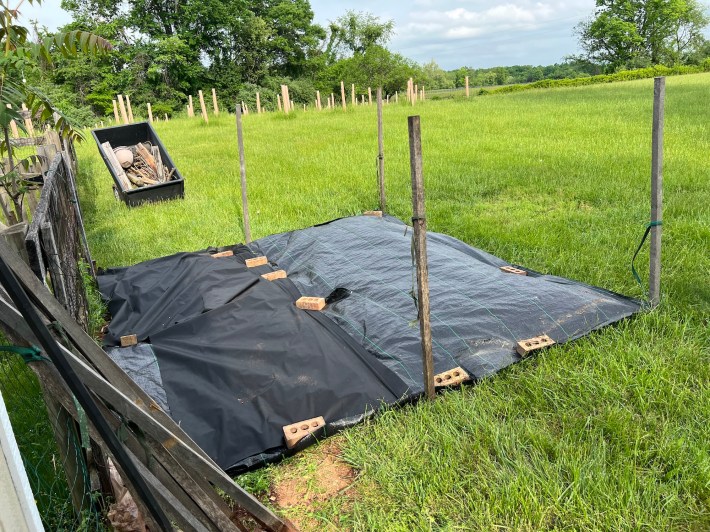
Then I used a roll of green welded wire mesh and a staple gun to make walls. Here I would like to brag that perhaps no person on earth is more capable with a roll of wire mesh and a stapler than I am. A close observer will note that the front of my house is lined here and there with carefully obscured wire mesh, onto which are growing various delightful twining and climbing things. Behold!
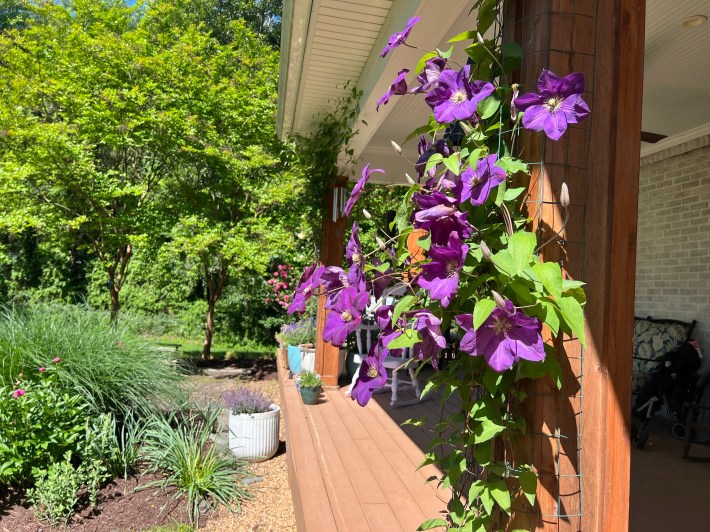
I did not fully enclose the garden plot with wire, because I still needed to get into and out of it, and in fact will need to get into and out of it all summer. We will explore the dare I say ingenious resolution of that logistical hurdle in a moment. But first, the time had come to plant maters.
I measured out space for six comfortable plants, with a wide lane between two rows for future ease of access. Then I used a box cutter to carve roomy X-shapes in the weed barrier paper, and folded back the flaps to expose little diamond-shaped openings of bare soil. My reasoning here was that I would want to fold the flaps back down, after planting, and maximally barricade the space around my tomatoes from the intrusion of weeds and grass. At some point in the future I will mulch the plants individually, for water retention purposes, and at some point further in the future I will cover the rest of the weed barrier paper, possibly with stone dust and pea gravel (ha!), but in the meantime I want coverage from the weed barrier paper so that nightmare jurassic-looking invaders can't overwhelm my sweet little darling plants.
I dug out these holes to a depth of about a foot, filling my wheelbarrow with clumpy, red, clay-heavy soil. I then mixed together in equal parts some of that shitty native soil, some fragrant black leaf compost, and some putrid cow manure, bags of which I had leftover from prior years' rose-potting conquests. By this point I was already filthy and drenched with sweat and desperate for a break; you're goddamn right I grabbed up and spread and stirred in the manure with my bare hands. It felt great!
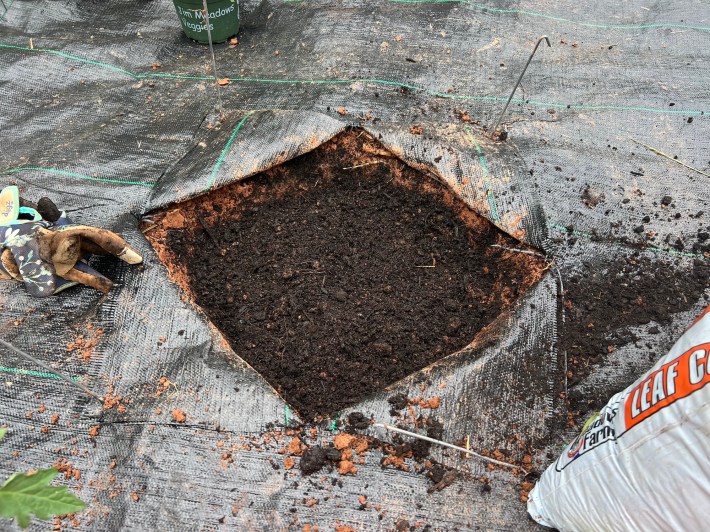
I planted the little baby tomato plants each in about 2.5 cubic feet of this mixture, gave each one a long bamboo rod for later support purposes, and closed the flaps around them. Then I sliced up some cheap plastic grower pots and lowered a ring to the base of each plant, pinning the rings in place with those trusty metal garden stakes. Into these rings I will later deposit hardwood mulch, when the time comes to protect the roots from blazing summer temperatures. I will want the plants to have mulch, but I will not want the mulch to blow all over the place or be washed away, and I don't want to have to heap it up real high. To me this improvised plastic ring solution was Pure Genius, and reused some garden jetsam that is otherwise garbage.
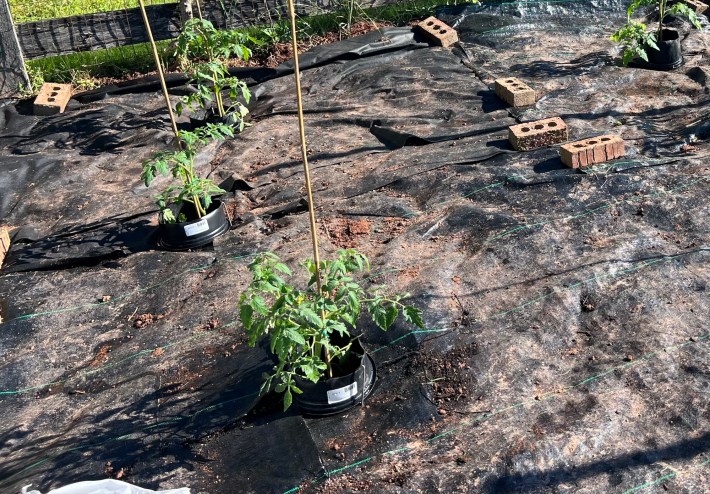
Having thus installed my tomato plants, I now needed to see about closing up my little garden, but in such a way that I could access it later. This would require some sort of movable section of wall, one that could be swung open to provide access and then closed to repel hungry wildlife. To accomplish this, I invented something that I am calling "a gate."
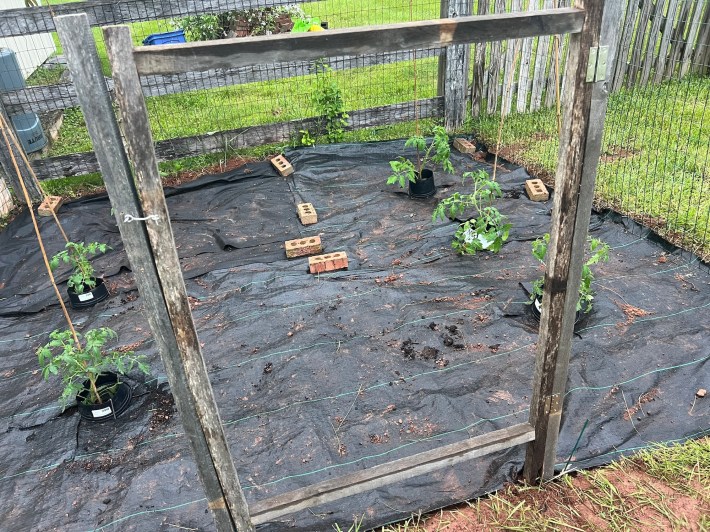
More old half-rotten wood tree stakes, cut to size with the mitre saw and then fastened together with three-inch exterior deck screws, leftover from the time when my wife and I needed most of two years to expand our front porch. Among the shit heaped on shelves in my basement were a box of hinges (from the time I told myself I would reaffix the door to my shed, which subsequently blew over in a blizzard), and a hook-and-eye latch assembly (from the time I told myself I would construct a small treehouse in the woods for my then-unborn child); I used these forgotten fixtures to hang my amazing garden gate and to latch it shut. Then I lined the gate and the walls to either side in more wire mesh. Voila!

It's not beautiful. Also, it will surely fail in ways that I can only faintly begin to anticipate. For one thing, I have watched deer leap over the equally high fence into my backyard, so this flimsy wire mess cannot entirely deter their grazing. For another, there is a dastardly invasive Tree of Heaven sapling intruding at the back of my tomato garden, and I feel reasonably certain that its aggressive growth habit and toxic roots will do bad things to my tomato plants if I can't get rid of it, something that is notoriously difficult to pull off. Also my hose reaches most of the way but not the entire way to this little square of space, and I will not allow myself to ever buy any more hoses (I have five of them), so watering these little beauties will not be the breeze that it should be.
But! I had all this stupid grass, and I had all this stupid weed barrier paper, and I had all these stupid tree stakes, and I had all this stupid wire mesh, and now I have a little garden space that may even possibly produce some tomatoes. There's room in the front corners to pot some peppers and some eggplant, and room in the back corners to pot whatever else. There's room along the perimeter to plant marigolds and nasturtium and distract all the pests. There's a lane down the middle for flagstones (I've got an ancient pile of those at another edge of the woods, from another abandoned project). There is every reason to hope that this structure will still be standing approximately one year from today, so that it can serve again next growing season, perhaps with some fortifications or renovations, or maybe even an expansion! In my wildest dreams, five years from now this thing is six times larger, is on both sides of the shed, has real-deal fence posts, and produces a lavish bounty of vegetables and fruit at harvest time. I have to kind of angle my line of sight away from this doofy little plot when I say this, but: I'm on my way!
The lesson here is one of encouragement: Anyone can convert a little patch of grass into a place to try out growing tasty things, and without having to buy anything. The trick is simply to have already purchased every dumbass garden implement ever invented, and then to have left them heaped up in a crumbling shed for years and years. Then you too can be a Handy Do-It-Yourself Type, and live off the land.






